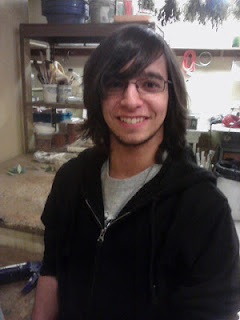 What's a hot "must-have" for your garden containers that's free, available in your yard right now, and sure to keep containers cool? Meet the humble mudcoat. It's natural, fun and very trendy - despite its rustic roots.
What's a hot "must-have" for your garden containers that's free, available in your yard right now, and sure to keep containers cool? Meet the humble mudcoat. It's natural, fun and very trendy - despite its rustic roots.I was told by a farmer that pigs like to roll in the mud because it is soothing and cools their bodies when temperatures rise. They may do it for comfort,and don't care how they look ... but I have found that mud can make hypertufa containers look great! In fact there's something truly special about a natural, weathered mudcoat applied to a hypertufa container.
Planting containers are available in many different materials, sizes and designs. Wondering how to enjoy the mudcoat on hypertufa this summer?
Let the plant steal the show: No matter what, I like to follow the rule that the container should play second fiddle to what is planted within. There are times when bright color and pattern are appropriate on the surface of a container and there is nothing like good old exterior latex paint for this purpose. Most times however, a muted, naturalfinish works best. Time and weather usually create a nice natural looking surface but it takes a long time to get there.
Consider the finish: I usually am working with brand new containers, specifically concrete and/or hypertufa. These are both natural finishes, but they are too clean and too gray and need something to integrate them into the garden setting. Especially those containers we make using recycled paper. These surfaces can be changed with all sorts of finish solutions from the craft or hardware store but usually come with a hefty price tag.
Put on Your Mudcoat: I have discovered a very simple technique for giving ceramic, concrete or hypertufa a wonderful natural finish we’ll call "mudcoat". It uses materials you already have at home in your garden…dark garden soil and water.
Creating a mudcoat:
1. Look around for a spot with dark soil, even dense clay will work for this, in fact, it is what you want versus composty loam - no mulch, potting soil or sand---just good dark soil. Cover about 4 cups of soil with water to cover and stir vigorously, making a thick, brown, creamy goo! Use an old window screen to strain the mixture into another plastic container and you are ready to go.
1. Look around for a spot with dark soil, even dense clay will work for this, in fact, it is what you want versus composty loam - no mulch, potting soil or sand---just good dark soil. Cover about 4 cups of soil with water to cover and stir vigorously, making a thick, brown, creamy goo! Use an old window screen to strain the mixture into another plastic container and you are ready to go.
2. Wearing mudgloves, use an old brush to apply the mudcoat to
the surface of your container, making sure to cover everything with a thick
coating. Every surface should be covered and every hole filled, inside and
out. Eventually I found myself using
just my gloved hands to apply the coating because it was easier to rub the mud
into the surface of the container.
3. Allow the coated container to dry in the sun and then you
can plant it. Because the container is dry when you apply the mudocat, it
really soaks it in deeply and will stay on the pot even through rain and
weather. Over time, it will slowly wash
away but the deep color remains as a natural stain on the surface of your
container. You can’t get more natural
than that!
Join us to play in the mud and hypertufa materials at From the Summer's Garden - next workshop July 13 and 14!
Join us to play in the mud and hypertufa materials at From the Summer's Garden - next workshop July 13 and 14!

















